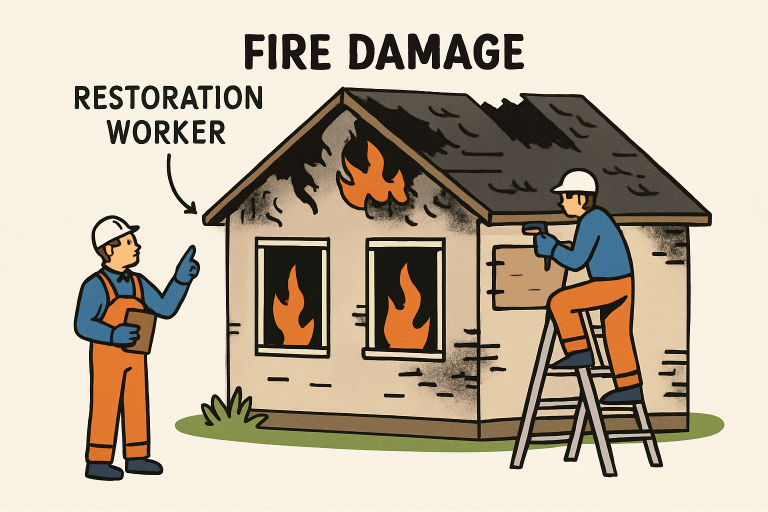Key Takeaways
- Prioritize immediate safety and secure the property quickly.
- Notify your insurance provider promptly to lay the groundwork for financial recovery.
- Engage certified restoration specialists for professional, safe, and efficient cleanup.
- The extent of damage influences the recovery timeline but generally includes several well-defined stages.
Experiencing a house fire can turn life upside down, leaving homeowners in a state of shock and searching for answers. The immediate priority is always the safety and well-being of all occupants. Once the flames are out and the fire department has cleared the property, the daunting process of recovery begins. Understanding the most effective steps to take—starting with securing your home, contacting your insurance, and pursuing smoke damage restoration services—can bring much-needed clarity and help initiate the path toward restoration.
Beyond the physical damage, handling insurance claims, repairs, and decisions about what can be salvaged are all challenging tasks. A structured approach is vital to reducing stress and maximizing recovery efforts; aligning with the right professionals and following a clear timeline will make the process more manageable and effective for families affected by fire disasters.
Immediate Actions Post-Fire
Once safety is confirmed and authorities have given the green light, secure the property against further damage by boarding up windows, covering roof openings, and addressing structural hazards. This crucial first step not only protects against vandalism and weather, but it also helps fulfill the requirements of most homeowners’ insurance policies.
Contact your insurer as soon as possible to report the incident and get guidance on your next steps. Begin documenting the damage—both structurally and to personal belongings—using photographs and detailed written notes. This documentation will be essential for insurance claims and subsequent restoration planning.
Engaging Professional Restoration Services
Enlisting professional restoration experts ensures that the cleanup and repair process is done safely, thoroughly, and in compliance with modern building codes. Trained specialists assess the scope of fire, smoke, and water damage, then devise a tailored restoration plan. Certified teams manage complex repairs and prevent secondary issues such as mold growth and lingering odors, which are common after house fires.
Restoration professionals are skilled at managing the intersection of fire, smoke, and water damage, coordinating the sequence of restoration tasks, and communicating with insurance adjusters. Their thorough methods can expedite the return to a livable home while safeguarding your health and the property’s structural integrity.

Understanding the Restoration Timeline
The timeline for house fire recovery varies depending on factors such as the severity of the damage, the size of the home, and the responsiveness of insurance and restoration teams. However, the process typically follows this general schedule:
- Days 1-3: Conduct initial damage assessment, secure vulnerable access points, and commence removal of debris.
- Days 4-7: Begin in-depth cleaning, extract standing water, and initiate the drying process to curb mold and further structural deterioration.
- Weeks 2-3: Move on to repairs of major structural elements—such as framing, electrical systems, and plumbing—to rebuild the home’s core.
- Weeks 4-6: Address cosmetic restoration: interior painting, installing new flooring, and finalizing fixture replacements.
These phases often overlap, but actual durations depend on the extent of fire and subsequent water damage, availability of replacement materials, and the speed of insurance approvals.
Salvaging Personal Belongings
Deciding what can be saved after a fire often depends on both the intensity of the blaze and the materials involved. Glass, metal, and some hard plastics can be cleaned and restored, although clothing, photos, documents, and upholstered furniture often sustain permanent damage from smoke and water. Work with restoration professionals who are experienced in content cleaning, and consult with your adjuster for policies regarding replacement versus cleaning.
In addition to material recovery, it’s important to be aware of the health risks associated with soot and chemicals that may settle on surviving possessions. Following professional advice ensures that salvaged items are safe to use and maintain your home’s health over the long term.
Preventing Future Fires
After recovery, taking proactive steps to prevent future fires is critical. Install interconnected smoke detectors on every level of the home, utilize fire-resistant roofing and siding, and schedule routine professional inspections of your electrical system and appliances. Establishing an effective, practiced fire escape plan can further safeguard your family.
Homeowners may also want to familiarize themselves with recommendations from national safety authorities, such as the National Fire Protection Association, for ongoing preventative education and risk assessments.
Seeking Support and Resources
The aftermath of a house fire is emotionally challenging. Local and national organizations, such as the American Red Cross, offer invaluable support services ranging from temporary housing and emergency supplies to emotional counseling. Community support groups and mental health professionals can assist with navigating the psychological toll, offering tailored advice and community connection during recovery.
Conclusion
The journey from fire devastation to full recovery is complex but manageable, with a clear and practical action plan. Prioritize safety, partner with experienced restoration specialists, and stay proactive about fire prevention for the future. By leveraging professional expertise, documented guidance, and personal support networks, families can focus on rebuilding both their homes and their lives, ensuring a safe and hopeful path forward.
Post HTML




Leave a Reply